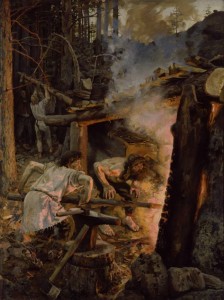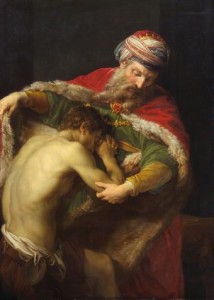Searching for a Metaphor that Connects
 “Give me my share of the inheritance” (Luke 15:11). With one small phrase the son callously declares that his Father is more valuable to him dead than alive.1 He dishonors his father, disregards his family, abandons his community and treats his religion with disdain. In the Muslim Sindhi society,2 a shame-honor context, there is no redemption for such shameful actions. The Jewish society of Jesus’ time was similar.3
“Give me my share of the inheritance” (Luke 15:11). With one small phrase the son callously declares that his Father is more valuable to him dead than alive.1 He dishonors his father, disregards his family, abandons his community and treats his religion with disdain. In the Muslim Sindhi society,2 a shame-honor context, there is no redemption for such shameful actions. The Jewish society of Jesus’ time was similar.3
How can we communicate the gospel cross-culturally? As we struggled with this task among the Sindhi people of Pakistan, my wife, Karen, insightfully noted that “the goal is not to make Sindhis understand the gospel (i.e., in terms of one specific model), but to make the gospel understandable.” The Bible provides us with a number of metaphors (salvation, justification, sacrifice, etc.) that reveal the meaning of the death and resurrection of Jesus. These metaphors were contextually sensitive to the first century audience, drawing on the experiences and concepts familiar to those readers. Explaining the gospel cross-culturally in our age requires us to discover suitable metaphors already present within a people group that will communicate the meaning of the cross in a way that both resonates with cultural understanding and is faithful to the message of the Bible.
 The danger for the cross-cultural minister is to consider one biblical metaphor, such as justification – a forensic term used by the apostle Paul to mean that through Jesus’ death God has declared us righteous – and develop it exclusively as the foundational understanding of the gospel. Such a narrow focus runs the danger of ignoring other biblical images that may connect more clearly and relevantly with the concerns and perspectives of the people group. In the initial article of this series I referred to my own experience in making this mistake. When presenting the gospel to the Sindhi people of Pakistan, I used one particular metaphor of a court scene that drew on the concept of justification. I came to realize that this image did not resonate with the perspective of the people with whom I was conversing. In order to correct this, I developed a different approach based on other biblical metaphors of the gospel. This article provides further detail about the picture of the gospel I began to use that connected with the way the Sindhi people view the world.
The danger for the cross-cultural minister is to consider one biblical metaphor, such as justification – a forensic term used by the apostle Paul to mean that through Jesus’ death God has declared us righteous – and develop it exclusively as the foundational understanding of the gospel. Such a narrow focus runs the danger of ignoring other biblical images that may connect more clearly and relevantly with the concerns and perspectives of the people group. In the initial article of this series I referred to my own experience in making this mistake. When presenting the gospel to the Sindhi people of Pakistan, I used one particular metaphor of a court scene that drew on the concept of justification. I came to realize that this image did not resonate with the perspective of the people with whom I was conversing. In order to correct this, I developed a different approach based on other biblical metaphors of the gospel. This article provides further detail about the picture of the gospel I began to use that connected with the way the Sindhi people view the world.
A good friend of mine was troubled with my response to the guest who challenged the court metaphor I was using. A part of my article is copied below with the objectionable phrases underlined:
To present the gospel, I would often use an illustration of a judge in order to communicate the need for Jesus’ death and resurrection. My argument was that if someone commits a crime, a just judge can’t forgive wrongdoing based on past good deeds; he must punish the crime. By implication, God cannot forgive our sins without payment or intervention from someone who can pay the price.
I had presented this scenario to my Muslim visitor. After thinking for a few minutes he said, “It is true that a judge must be just, but a just judge can also be merciful. Mercy need not be in conflict with justice, and God is a merciful God. God can forgive without undermining justice.” I had been long enough in the country to realize the implication of this statement and I was struck silent for a time. I finally replied, “You are right. I will need to think about this.”
My friend summarized the interchange as follows, which revealed his concern:
You: God cannot forgive sin without payment or intervention.
Guest: God can forgive sin without payment or intervention.
You: You are right.
this particular image … was not communicating
By putting it in this point form I see why he was disturbed, because such a rendering could imply that Jesus’ death is not necessary for salvation! This was not my intent. Rather, my response was a recognition that this particular image of the meaning of the cross was not communicating in a significant or appropriate manner. It was an “aha” moment for me that initiated the search for a metaphor that would make sense to Sindhi ears.
Identifying the Sindhi Perspective
 Living apart from his father, his family and his community, the son has no one to help him in desperate times. He knows that he cannot return. He has burned his bridges. But then he has an idea, “Not as a son, nor even as a servant in the house, but maybe as a hired worker! I can earn my living and even start to pay back what has been lost.4 Perhaps the mercy of the father will extend that far.” He begins the journey home.
Living apart from his father, his family and his community, the son has no one to help him in desperate times. He knows that he cannot return. He has burned his bridges. But then he has an idea, “Not as a son, nor even as a servant in the house, but maybe as a hired worker! I can earn my living and even start to pay back what has been lost.4 Perhaps the mercy of the father will extend that far.” He begins the journey home.
I began my ministry in the Sindh with the assumption that the Sindhi people approached salvation from a theology of works. That is, their hope was in their own ability to do more good deeds than bad and thus be able to enter heaven. The criteria for salvation was a simple accounting algorithm: When good – bad = +ve, then heaven is the reward. My use of the penal substitution imagery addressed this view by demonstrating that good deeds cannot mitigate the wrong that we have done. Our only hope is if someone will take our punishment for us. What I did not realize, until my conversation with my guest, was that I was addressing the wrong assumption. Due to the influence of Sufism (the mystical side of Islam), the majority of Sindhis with whom I was communicating were neither denying the seriousness of their sin, nor attempting to accumulate credits from good deeds to be applied against the wrong that they had done. Instead, their hope for salvation lay in the mercy of God to forgive.
their hope for salvation was in the mercy of God to forgive
Thus, when I said, “You are right,” I did not mean “God can forgive sin without payment or intervention.” What I meant was “You are right. This explanation of salvation does not adequately address your trust in God’s mercy.” I also meant, “You are right. In human courts a just judge can forgive without punishing.” When it is obvious that a person’s character has changed and they have repented from their sin, the judge can decide that this “new” person should no longer be identified with the past sin, and therefore say, “I do not condemn you. Go and sin no more.” And this would be just, because true justice makes things right. Because the person’s orientation has changed, they do not require punishment (although restitution may be another issue). We understand this as parents and refrain from punishing children who show genuine remorse. The goal is the restoration and correct orientation of the child to what is good, not a legalistic conformity to a sin / punishment paradigm.
A Resonating Image: Jesus as the Mercy of God
 Even before the son could begin his speech of repentance, before he can articulate his plan of being hired and working his way back into the community, the father has come running – RUNNING! To the shock of all, he abandoned the dignity and pride of the patriarchal position in order to embrace the son who had shamed and humiliated them all.5 The father calls for his best robe to cover the rags, his signet ring to restore the son’s position and shoes to remove the shame. In the Sindhi culture, the feet are the place of shame. One of the greatest insults is to remove your shoe and show the bottom of it to another person. In a series of swift commands the consequences of the son’s sin are swallowed up by the father’s mercy. With no regard for the shame, pain or loss that he suffers from this act, the father removes the obstacles between him and his son and calls for a celebration. Forgiveness is never free, someone always suffers.
Even before the son could begin his speech of repentance, before he can articulate his plan of being hired and working his way back into the community, the father has come running – RUNNING! To the shock of all, he abandoned the dignity and pride of the patriarchal position in order to embrace the son who had shamed and humiliated them all.5 The father calls for his best robe to cover the rags, his signet ring to restore the son’s position and shoes to remove the shame. In the Sindhi culture, the feet are the place of shame. One of the greatest insults is to remove your shoe and show the bottom of it to another person. In a series of swift commands the consequences of the son’s sin are swallowed up by the father’s mercy. With no regard for the shame, pain or loss that he suffers from this act, the father removes the obstacles between him and his son and calls for a celebration. Forgiveness is never free, someone always suffers.
Because of my new understanding of the Sindhi context, I realized that I needed a different picture of the cross that would address their perspective. They don’t need to be told that they are sinners; they know that already. They don’t need to be taught that good deeds don’t outweigh the bad; they are aware of their inability to attain that assurance. They don’t need to be taught that God is merciful because that truth is repeated continuously throughout the day. One of the most common Arabic phrases I heard during my time in the Sindh was bismallah, a rahman, a raheem – in the name of God, the most merciful, the most gracious.
Jesus is the mercy of God
Through the interaction with my visitor I came to realize that what Sindhis need is an explanation of how Jesus is the mercy of God; how Jesus is the way to that “new birth,” to becoming holy, to becoming a “new creature.” They need a picture of salvation in which Jesus becomes sin for us by entering into our separation from God on the cross so that we can access that mercy. He became one with us – the Word became human (Jn 1:14) – and that incarnation was completed on the cross when he cried, “My God! My God! Why have you forsaken me?” (Mark 15:34). While on earth Jesus was never totally one with us until the cross. He was sinless, his relationship with the Father was not broken, until the cross. But on the cross he took our sin, our death, our hell, on himself so that we could live. Jesus is the way that the mercy of God is realized in our lives. Now those who do repent and humbly turn to Jesus are “in Christ” and therefore become alive to God. He became one with us in our separation from God so that we could become one with him in union with God. God freely forgives, because of what it cost Jesus.
God freely forgives, because of what it cost Jesus
This image resonates with the Sindhi worldview and perspective of God as merciful and forgiving. The problem with the metaphor of the court setting was that it communicated to Sindhi ears that God could not be merciful. He needed to punish someone because of a legal difficulty that he could not set aside. That is, the court metaphor created a contrast between God’s mercy and his punishment, and in this way miscommunicated the gospel as if God’s need to punish took precedent over his mercy. What they needed was a realization that the work of Christ in taking the punishment was God’s way to pour out his mercy. What I needed to contextualize the gospel was an image of salvation that affirmed what they already believed about the mercy of God, but put it squarely in the context of Jesus’ work of salvation, his substitutionary atonement on the cross. Because Jesus died – as an expression of God’s mercy rather than a focus on punishment – we do not. George MacDonald’s quote resonates well with the Sindhi context: “It satisfied love to suffer for another, but it does not satisfy justice that the innocent should be punished for the guilty.”
The True Older Brother
Forgiveness is never free, someone always suffers
The older son is furious. He does not appreciate the father’s love and mercy. Nor does he value the father’s concern for relationship. His heart, like the younger son’s, is focused on the benefits he gained from the father, not on the father himself.6 In shame-honor cultures mediation is the norm rather than direct confrontation, and it is often the older brother’s responsibility to seek out and restore those family members who have gone wrong. This is true for the Sindhi context. In the story, the older brother not only neglected this role, but is now furious when his brother is restored. However, there is another older brother implied by this scenario who needs be mentioned. Jesus is the older brother who responds in stark contrast to the older brother in the story.7 He is the one who did come to seek and save, who did come to suffer and die, who did come to bring life to the dead. Such mercy is costly. Forgiveness is never free, someone always suffers.
 There is an appealing Islamic saying told to me by the leader of a Islamic group in Canada, “God has given 1% of his mercy to the earth, and reserved 99% for the day of judgment.” It is appealing for it grasps the grandeur of God’s graciousness and love towards human beings. But it is not Christian. The message of the cross proclaims that God has reserved none of his mercy for a later time, but has poured it all out on the cross. Jesus is the mercy of God. “In Christ” we experience the full mercy of God.
There is an appealing Islamic saying told to me by the leader of a Islamic group in Canada, “God has given 1% of his mercy to the earth, and reserved 99% for the day of judgment.” It is appealing for it grasps the grandeur of God’s graciousness and love towards human beings. But it is not Christian. The message of the cross proclaims that God has reserved none of his mercy for a later time, but has poured it all out on the cross. Jesus is the mercy of God. “In Christ” we experience the full mercy of God.
In the next article I will address the inevitability of using metaphors to communicate the gospel and the importance of choosing culturally sensitive metaphors. In a further article I hope to demonstrate the value of holding as the heart of the gospel Alistair McGrath’s phrase “the saving action of God toward mankind in Jesus Christ,”8 when seeking contextually relevant metaphors.
Mark spends part of his time assisting churches in developing significant cross-cultural relationships. If you are interested, please contact him via the Contact Me form. If you would like to leave a comment about this article, please use the “comment” link at the bottom of this article.
____________________
- 1 Bailey, K The Pursuing Father at http://jmm.aaa.net.au/articles/2367.htm, see also Bailey, K 1976 (1983 combined Ed). Through Peasant Eyes: A Literary-Cultural Approach to the Parables in Luke Grand Rapids: Eerdmans, p. 162 and Keller, T 2008. The Prodigal God: Recovering the Heart of the Christian Faith. New York: Dutton, p. 18.
- 2 Mark and his wife, Karen, worked among the Sindhi people for 14 years.
- 3Malina, BJ 1981. The New Testament World: Insights from cultural Anthropology. Louisville: John Knox Press, pp 25-50.
- 4 Keller 2008. p. 21.
- 5 Bailey 1976, pp. 181-182. See also Rohrbaugh, RL 1997. A Dysfunctional Family and Its Neighbours in Jesus and his Parables: Interpreting the Parables of Jesus Today, V. George Shillington (Ed). Edinburgh: T&T Clark, 141-164, p. 158.
- 6 Keller 2008, pp. 49-50,53-56,58-59,62. See also Nouwen, HJM 1992. The Return of the Prodigal Son: A Story of Homecoming. New York: Doubleday. pp. 20-21.
- 7 Keller 2008. pp. 80-81.
- 8 McGrath, A 1986. Iustitia Dei: A History of the Christian Doctrine of Justification from 1500 to the Present Day. Cambridge University Press, pp. 1:2-3.
